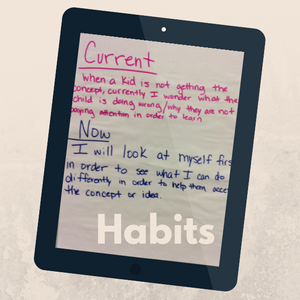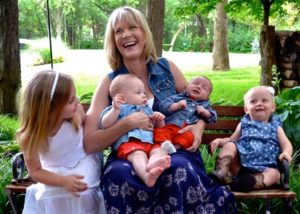 Ever felt frustrated by the lack of change in practice, even following our own “fabulous and sage advise”?
Ever felt frustrated by the lack of change in practice, even following our own “fabulous and sage advise”?
Ever considered the role habits play in getting to a change in practice?
In this post, co-author Misty Goosen and I explore how habits are an unaddressed, yet, active ingredient when training, coaching, and supporting adult learners to change their current practices.
Habits are not an element of implementation science, or other research to practice efforts.
A habit is what some call the fundamental principle where a cue or antecedent triggers or stimulates a response (conscious or unconscious, desired or undesired), which is then strengthened or weakened, based upon the subsequent reward (aka consequence or feedback).
Through our work and research, we have become convinced that we need to better understand habits as a key aspect of human behavior and change.
Today, we explore habits as an “active” ingredient for change from the lens and work of Crystal Pirri (@CrystalBPirri), who wrote “The Complete Guide to Mindful Habits: 9 steps to Permanent Change.“
Crystal’s Key Messages About Habits
- Habits are just a series of moments that are grouped together…a story you tell yourself and others about the choice you’re making today.
- Every time you say your habit and believe it to be true, you’re actually making it so.
- If there is something you want to start or stop doing, you can, but only one moment at a time.
Suggestions for Applying Crystal’s Key Messages
In her book, Crystal offers 9 steps to more mindful habits…four steps to break habits, and five steps to help create new habits.
In the context of delivering professional development/professional learning, we want to offer a couple of ideas related to two of the nine steps.
#1 How To Break Bad Habits – Ignore your old decision, and stop reinforcing it.
Let’s say you are facilitating a training on how to deal with children’s “challenging behaviors,” or how to write more meaningful IFSP/IEP outcomes and goals.
Before talking about content related strategies and ideas you have to offer, ask the participants to make a list of 5 thoughts or things they say about children and their “challenging behaviors” or about their practices around writing outcomes/goals.
#2 How to Create New Habits – Be present with your choice now.
One of the things we like about Crystal’s book is that she focuses on both breaking AND creating habits. One of her suggestions, under creating, is related to being present.
Now wait…before you shake you head and say, “I’m never able to be present”…remember what we just discussed about changing how we think and what we say. Perhaps “up until now” you’ve had trouble being present…but that doesn’t mean it will always be this way.
It’s easy to fall into our old habits…We know!
But…let’s return to the situation where you are facilitating a training on how to deal with challenging behaviors or how to write more meaningful IFSP/IEP outcomes and goals.
To help participants create new habits, they need to stop comparing the current situation to the past, or thinking about what will happen in the future.
For example, when a child has a meltdown, participants need to block thoughts about how the last time this happened, it caused a major disruption for the rest of the day, or that it took two adults and 60 minutes to help the child calm down.
Rather, they should take a deep breath and just be present for the child, which conveys a sense of readiness to support and understand how the child is feeling.
Likewise, when thinking about the stack of IFSPs or IEPs that need to be written, encourage participants to block memories of how long it took them the last time they had this many evaluations in one week, or from thinking about the emails that are piling up with new referrals. Instead, ask them to find some way to enjoy what they are doing right at that moment (e.g., helping to identify needed services for a young child).
Can you see how being present helps the adult learner feel confident in their ability to engage in new practice?
There are many take-away messages from her book; however, there are two phrases or ideas that Misty and I are continuing to think about in terms of our own habits and in our work in delivering effective professional development and learning opportunities.
What old story isn’t working for us anymore?
What would we like to think instead?
Miss part one of this three part blog series?
Go here for part 1 “Looking For a Change? Start With Your Habits!”, and here for part 3, “Getting To Change in Three…Ok…Four Simple Steps”.
 Guest Blogger – Misty Goosen @mgoosen77 (or on LinkedIn)
Guest Blogger – Misty Goosen @mgoosen77 (or on LinkedIn)
Since 1994, Misty Goosen has worked as the Project Coordinator for the Kansas Inservice Training System (KITS), where she provides training, technical assistance and consultative services to adults working with children with disabilities (birth through age 8). Areas of focus include Primary Service Provider approach to service delivery, Routines Based Interview/Intervention, Results to Intervention, Challenging Behavior, Evaluation/Assessment, Curriculum/Standards, and Conflict Resolution. Misty has served on the Division of Early Childhood Executive Board, is a Past Kansas Division of Early Childhood President, and received the 2008 KDEC Award of Excellence for making significant contributions to the field. She has chaired and/or organized numerous conferences (e.g. KDEC, Transitioning into Developmentally Appropriate Practice, KITS Annual Summer Institute) and has participated in activities such as Head Start monitoring and NAEYC validation. As a past member of the Kansas Multi-System of Supports (MTSS) Core Team, Misty worked to integrate preschool into the overall state supported model. Before coming to KITS, Misty worked as a school psychologist, and early childhood coordinator for the Turner School District, in Kansas City, Kansas.